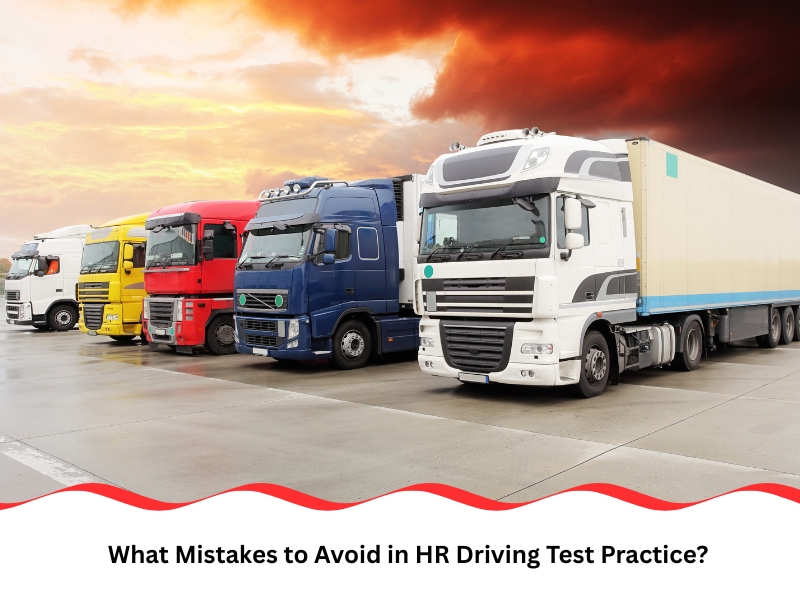Preparing for your HR (Heavy Rigid) driving test takes more than basic driving ability. It demands sharp observation, sound judgement, and mastery of a large vehicle under varied conditions. Many drivers head into their test with high hopes but fall short due to avoidable mistakes. By understanding what these mistakes are and how to sidestep them, you’ll give yourself the best shot at success. This article explores how to approach your hr driving test practice with confidence and precision.
How can poor preparation impact your overall driving performance?
Poor preparation can derail even experienced drivers. It’s one thing to drive comfortably on familiar roads — another to handle a large truck in a high-pressure test environment. Without targeted practice, drivers often experience:
- Sluggish responses to traffic signals and road hazards — delayed braking or failure to notice signs
- Struggles with gear selection and smooth transitions — rough gear changes cause instability
- Poor understanding of vehicle size and turning clearance
- Inconsistent mirror use and blind spot awareness — missed vehicles in adjacent lanes
Another common trap is overestimating your readiness. A casual weekend drive won’t prepare you for the strict criteria assessors apply during the HR driving test. Focused, deliberate preparation is essential to avoid unpleasant surprises on test day.
What common mistakes happen during hr driving test practice?
Certain errors pop up time and again during hr driving test practice. Recognising them early gives you time to correct them before test day. Typical mistakes include:
- Failing to check mirrors thoroughly — incomplete checks result in penalties
- Rolling stops at intersections — not bringing the truck to a complete halt
- Unsafe following distances — leaving too little space increases the risk of collision
- Misjudging braking time — heavy vehicles require more time to stop
Another pitfall is letting nerves creep in and rush your decision-making. Taking corners too quickly or hesitating during lane changes often results from test-day anxiety.
Staying consistent with your practice routine will help build muscle memory and mental discipline, reducing the likelihood of these errors on your assessment.
What role does test anxiety play in driving mistakes?
Test anxiety is a powerful force — it can undo weeks of good practice if not managed well. Under stress, drivers may:
- Forget essential tasks — missing steps like mirror checks and signals
- Overcorrect steering or braking too sharply — sudden movements impact vehicle control
- Second-guess decisions — hesitation confuses other drivers
- Display physical tension — rigid posture affects reaction time
It’s not enough to be technically competent. You also need mental resilience to perform calmly during your test.
One proven approach is to simulate test conditions in your practice runs. Have your instructor observe silently and use formal marking criteria. The more familiar you become with this experience, the better you’ll handle it when it matters.

How can you correct bad habits through hr driving test practice?
Even seasoned drivers bring bad habits into HR training, and they often aren’t aware of them. Common habits to correct include:
- Relying too much on brakes — over-braking wears out equipment and causes jerky stops
- Neglecting head checks — missing necessary visual checks before lane changes
- Resting the left foot on the clutch pedal causes unnecessary clutch wear
- Forgetting to adjust for load weight — different weights affect vehicle handling
The key to fixing these issues is deliberate, focused practice. You’ll need feedback from an experienced instructor and plenty of repetition.
For a systematic approach, it’s wise to explore comprehensive hr driving test practice options for aspiring drivers. Such programs help isolate problem areas and guide you in building correct habits that will serve you well beyond the test itself.
What techniques help you prepare for the hr driving test effectively?
Effective preparation is about working smarter, not just clocking hours behind the wheel. Consider these strategies:
- Structure practice into short, focused sessions — avoid long, tiring sessions that reduce learning quality
- Mix urban driving with open-road conditions — prepare for all driving environments
- Practise in varied weather and traffic scenarios — build adaptability and confidence
- Include mock tests with instructor feedback — get used to test-style pressure.
It also pays to understand how hr licence training enhances essential driving skills. Structured training often highlights subtleties, such as weight transfer during braking, that casual practice alone may not cover.
By building these techniques into your routine, you’ll steadily develop the consistency and confidence needed for test day.
How can a structured learning plan improve your test success rate?
A structured learning plan ensures you cover every skill required, not just those you feel comfortable with. Here’s an example of how a balanced plan looks:
Focus Area | Why It Matters | Sample Activities |
Core driving skills | Ensures competence across manoeuvres | Gear changes, cornering, reverse parking |
Hazard perception | Sharpens traffic awareness | Identifying risks, responding appropriately |
Test simulation | Builds comfort under test conditions | Mock tests with marking sheets |
Feedback review | Targets weak spots | Instructor debriefs, self-reflection |
A structured plan also helps reduce information overload. You won’t be scrambling to cram last-minute fixes the night before your test.
It’s worth drawing insights from effective strategies to lower hr licence practice test failure rates when crafting your plan. These strategies have helped many drivers focus their preparation and improve outcomes.
What should you focus on after completing your hr driving test practice?
After completing hr driving test practice, your goal shifts to maintaining consistency right up to test day. Key priorities include:
- Reviewing feedback from mock tests — focus on areas where errors were frequent
- Keeping up a regular driving rhythm — avoid long breaks between practice sessions
- Practising relaxation techniques — breathing exercises and positive visualisation reduce nerves
- Prioritising quality sleep — being rested helps you stay alert and calm
It’s also smart to refresh your understanding of important skills assessed in the heavy vehicle driving test. This ensures your efforts remain targeted and aligned with what assessors are looking for.
Final thoughts
Success in the HR driving test depends not only on your technical ability but on preparation, consistency, and the ability to perform under pressure. By addressing common mistakes and building a structured learning approach, you’ll set yourself up for a positive result.
If you’re ready to take the next step, you can connect with Core Truck Driving School to begin your driving journey and move forward with confidence.


